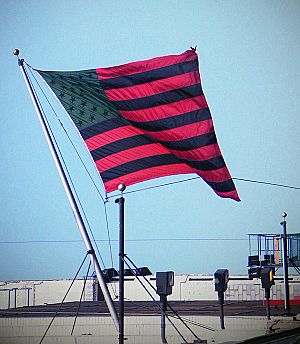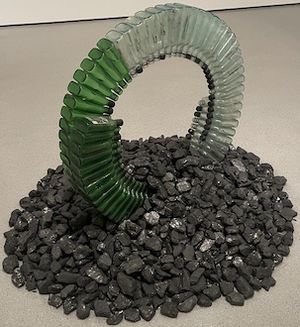David Hammons facts for kids
Quick facts for kids
David Hammons
|
|
|---|---|
| Born | July 24, 1943 Springfield, Illinois, U.S.
|
| Education | CalArts, Otis College of Art and Design |
|
Notable work
|
Bliz-aard Ball Sale (1983) Free Nelson Mandela (1987) How Ya Like Me Now? (1988) Untitled (African-American Flag) (1990) Day's End (2021) |
| Movement | Postmodernism, conceptual art |
David Hammons (born July 24, 1943) is an American artist. He is famous for his unique artworks in New York City and Los Angeles. He often uses everyday objects to create art that makes people think.
Contents
Early Life and Education
David Hammons was born in 1943 in Springfield, Illinois. He was the youngest of ten children raised by a single mother. His family did not have a lot of money, which was difficult for them.
From a young age, Hammons was talented at drawing. In 1962, he moved to Los Angeles to study art. He attended the Chouinard Art Institute (now CalArts) and the Otis Art Institute. At school, he learned from famous artists like Charles White, Bruce Nauman, and John Baldessari.
In Los Angeles, Hammons met other artists and formed a group called Studio Z. This group, also known as the LA Rebellion, worked together on art projects. In 1974, Hammons moved to New York City, where he still lives and works today.
Personal Life
Hammons prefers to keep his personal life private. He believes his art should speak for itself. He doesn't want his personal story to change how people see his work. He once said, "The way I see it, the Whitney Biennial and Documenta need me, but I don't need them." This shows his independent spirit.
Hammons is also known for supporting other Black artists by buying their work and helping them become known.
His Unique Art Style
David Hammons does not have one single style. He creates many different kinds of art, including sculptures, drawings, and performances. His work is often compared to conceptual art, where the idea behind the art is the most important part.
Much of his art explores what it means to be a Black person in American society. He uses metaphors, which are ideas or objects that stand for something else. These metaphors become powerful symbols. One art expert said that Hammons "plays with art the way a jazz musician plays with sound."
Body Prints
When Hammons started his career in the 1960s, he made art using his own body. He would cover his body in grease or oil, press himself against a sheet of paper, and then sprinkle powder on it to create an image. These are called body prints.
Many of his body prints were about the Civil Rights Movement and Black Power movement.
- Injustice Case: This famous work shows Hammons tied to a chair. It was a comment on the unfair treatment of Bobby Seale, a political activist, during a famous trial. The artwork shows the struggles faced by African Americans.
- The "Spade" Series: In the 1970s, Hammons created a series of works using the word "spade." At the time, this was a hurtful term used against African Americans. Hammons used the word and the shape of a garden spade in his art to challenge the term's negative meaning and turn it into a "badge of honor."
- Black First, America Second: This 1970 work shows two images of Hammons wrapped in an American flag. It represents his feeling of having two separate identities, his Black self and his American self, that were in conflict.
Sculptures from Everyday Objects


Hammons became famous for making sculptures out of found or discarded items. He used things like chicken parts, hair from barbershops, and empty bottles. He saw a special power in these materials.
- African-American Flag: In 1990, Hammons created one of his most famous pieces. He took the American flag and changed its colors to black, red, and green. These are the colors of the Pan-African Flag, a symbol of Black pride. A version of this flag flies outside the Studio Museum in Harlem.
- In the Hood: This simple but powerful sculpture from 1993 is just the hood from a sweatshirt, mounted on a wall. It makes people think about the experiences of young Black men in America. After the killing of Trayvon Martin, many people used images of this artwork on social media to support the Black Lives Matter movement.
- Higher Goals: In 1986, Hammons built a basketball hoop that was three stories tall. The piece commented on how becoming a sports star is an almost impossible dream for many young people. Hammons said, "not everyone will make it, but even if they don't at least they tried."
- Day's End: In 2021, Hammons created a large public sculpture on the Hudson River in New York. It is a "ghost monument," meaning it's an outline of a building that is no longer there. The sculpture is a tribute to an earlier artwork by artist Gordon Matta-Clark.
Performance Art
Hammons also creates performance art, where the artwork is an action or event.
- Bliz-aard Ball Sale: In 1983, Hammons stood on a street corner in New York City and sold snowballs. He priced them based on their size. This performance was a funny comment on how art is bought and sold, and what people consider valuable.
- Concerto in Black and Blue: For this exhibition, Hammons made the entire art gallery pitch black. Visitors were given tiny blue flashlights to find their way around. This challenged the usual way people look at art in a bright, white gallery.
Influences
Music has been a big influence on Hammons. He has paid tribute to jazz musicians like Charlie Parker and Miles Davis. The title of his work How Ya Like Me Now comes from a song by Kool Moe Dee.
Another major influence is the French artist Marcel Duchamp, who was famous for turning ordinary objects into art. Hammons has even called himself the head of the "Duchamp Outpatient Clinic."
Awards
In 1991, Hammons received a MacArthur Fellowship, which is often called a "Genius Grant." This award is given to talented people in many different fields.
Notable works in public collections
- Injustice Case (1970), Los Angeles County Museum of Art
- Three Spades (1971), Glenstone, Potomac, Maryland
- Body Print (1975), Museum of Modern Art, New York
- Flight Fantasy (1978), Walker Art Center, Minneapolis
- Free Nelson Mandela (1987), Piedmont Park, City of Atlanta Mayor's Office of Cultural Affairs
- How Ya Like Me Now? (1988), Glenstone, Potomac, Maryland
- Untitled (Night Train) (1988), Museum of Modern Art, New York
- Untitled (African-American Flag) (1990), The Broad, Los Angeles; Museum of Modern Art, New York
- Money Tree (1992), Museum of Modern Art, New York
- Untitled (1992), Whitney Museum, New York
- Praying to Safety (1997), Museum of Contemporary Art, Chicago
- Phat Free (1995-1999), Art Institute of Chicago; Tate, London; and Whitney Museum, New York
- The Holy Bible: Old Testament (2002), Museum of Modern Art, New York
- Day's End (2014-2021), Gansevoort Peninsula, Meatpacking District, New York (maintained by Whitney Museum)

